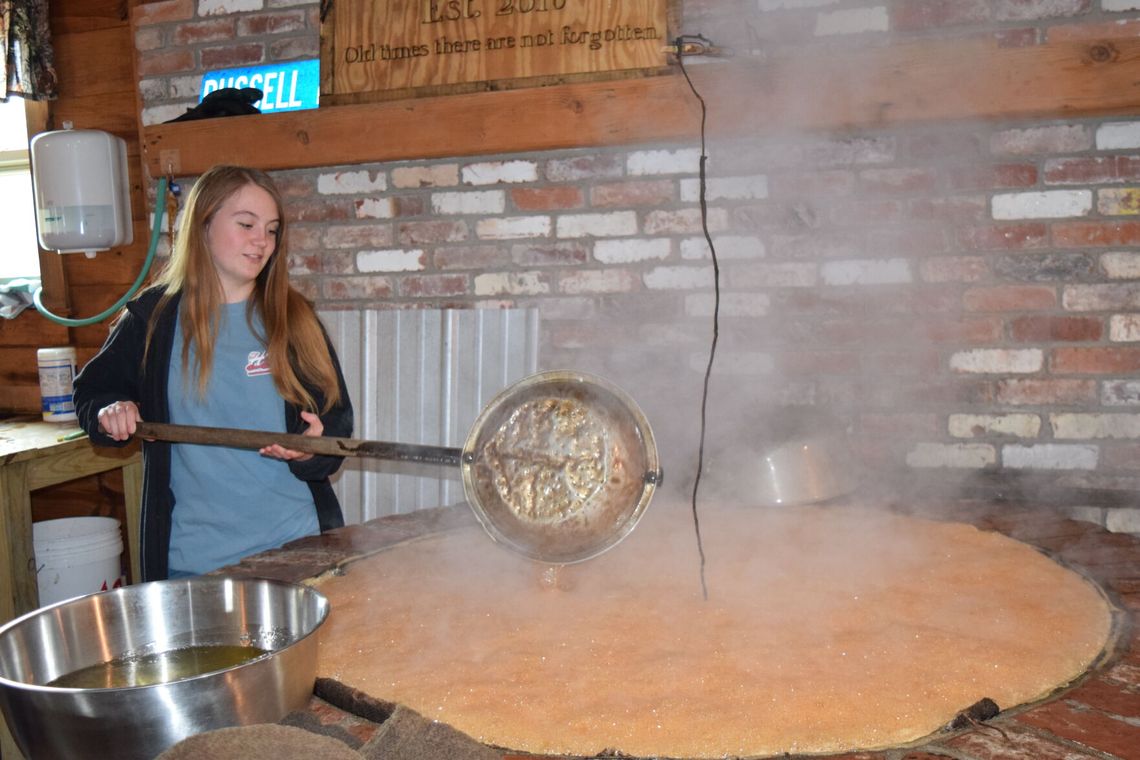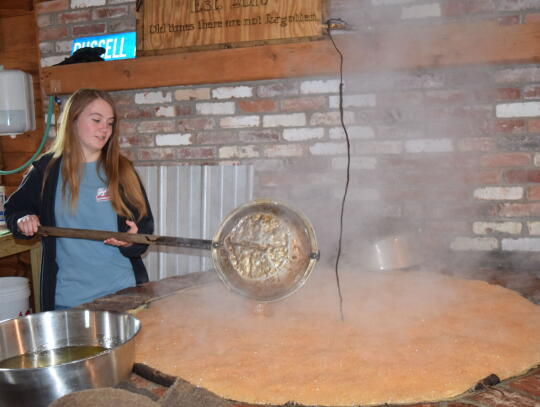Once a Southern staple, cane syrup has mostly fallen by the wayside except for some areas of south Georgia where making it is just as much fun as tasting it.
It is a truth universally acknowledged that a bunch of men standing around a fire must be in want of some banter. David Herrin and his small crew gathered the week of Thanksgiving to make the delightful product and the fire blazed, along with the conversation.
Odie Crews, who was overseeing the boiling of cane juice into syrup, stated he was the project “consultant,” which, he explained, “means I ain’t doin’ a lot of work.”
A burst of laughter adds warmth to the shelter already heated by a roaring fire made with oak and pecan wood and controlled by a thermostat.
Yet, it was likely around a fire like this one many years back where the first mysteries of cooking dinner blazed into revelation. And if that’s the case, then not much has changed except the location.
It was a brisk fall morning, and everyone was gathered on the Herrin farm to pitch in and get the tedious job done.
The rowdy fire howled inside a brick hearth built to support a massive kettle — five feet in diameter and weighing about 300 pounds — bubbling with 80 gallons of sugarcane juice, which would take some five hours to boil down to eight gallons of cane sugar syrup. The process involved a lot of watching. At various moments throughout the day, the whole lot sometimes just stood there, staring into the rolling boil, seized by a silent reverie old timers might recognize.
It’s hard to say which is more mesmerizing, the reddish depth of the juice bursting onto the surface in an amber lather, or just the kettle itself. There is no good English word for the simple beauty of this stunning object.
It is pure cast iron and shaped like an oversized cereal bowl. You could wash a couple of children in this thing or use it as a birdbath for pterodactyls. The curve itself is enough to pull you in, a shape that grabs the eye like the slope of a horse’s back.
There is a lot of history in this kettle. But for much of the last 100 years, cane sugar syrup was the main source of sweetness in small communities when everything else was too expensive. By lunchtime, the crew was looking into the foaming broth to catch that magical moment when the concentrated liquid would quickly thicken into syrup.
The syrup is said to be milder and more complex than the potent bullet of sweet that is granulated sugar. Was this just an exercise in old-timey fun? It sure seemed that way.
By mid-day, the general task of the day was already half accomplished - a quarter acre of sugarcane, about 1,ooo stalks, had been cut in about three hours the day before by the manager here. The cane was mashed and then the juice strained through a piece of cloth laid atop a croker sack and into a bucket.
By mid-morning, the juicing was done and the 80 gallons from the thousand stalks were in the kettle.
Herrin explained the process. Sugarcane is a perennial, but the cane starts to lose its sweetness in about the third year, so you have to buy new seed cane and lay it down. Each section of a cane stalk has a little eye in it. Seed cane is, simply, fresh-cut stalks laid end to end and buried. Each eye sends up a fresh stalk.
“You have to overlap them a little bit because the end pieces aren’t reliable,” Herrin said.
Another senior syrup consultant, Jok Johns, who occasionally contributed a blue joke to the fire, said, “Putting it on biscuits is heaven.”
Cane “syrup” is another term (like “kettle”) that sets the mind off in the wrong direction. People think of maple syrup and the sticky texture and candied density. But cane syrup is naturally thinner and only mildly sweet.
It doesn’t share with either maple syrup or Dixie crystals that tooth-aching bolt of super-refined sugar. The five-pound bag one buys in a store involves a series of processes required to extract and condense the sweet into those intense granules.
But cane sugar syrup, with the first boiling of cane juice, is where it all starts.
Emma Strickland, a sweet-natured, hard-working high school sophomore, takes great pride in helping with the job. She holds a long stick of wood with a metal bowl attached at the end, the bowl poked with holes to allow the syrup to flow quickly through without keeping any trash or debris from the cane stalks.
Once put to a boil in the kettle, the bubbling spume started to throw up the impurities that somehow made it through the cloth.
“So we remove all that with skimmers,” said Crews, who also pulled a homemade sieve through the amber bubbles. It’s a tin bowl poked full of holes wired to a broomstick.
“You can’t let the syrup get too hot,” Crews explained, grabbing another homemade tool. He dipped in a bowl — also poked full of holes and fastened to a broomstick — and then let the cooling juice rain back into the kettle. The juice was in a rolling boil, and just as boiling grits will foam up and spill over the stove, the juice can do the same.
“The reason you don’t want to cook it too hot,” Herrin said, pointing to the inside lip of the kettle, “is the juice can scorch right here where it meets the metal, and that later leaves a sediment in the syrup.”
The chore for the day was to keep the juice just at the boiling point before it foamed over. By late afternoon, the once-full kettle had dropped by two-thirds of its volume.
Then that edge of the kettle, where the thickening syrup touches the air, started to change. The syrup lapping at the edge left smudges of light brown cream. Herrin snapped a small stick from some kindling and scraped some goo from the side.
The real trick to making cane syrup is figuring out just when it is approaching the perfect thickness.
“In the old days,” Herrin said, “they would dip a pan into the syrup and watch how it dripped — looking for what they called scaling.”
It’s an inexact science, best left to very experienced syrup cooks.
“When it gets to 228, we want to pull the fire,” Crews said.
The syrup is then transferred from the kettle to a container where it is allowed to cool a little before being pored into bottles. The trick is to get it off the heat just before, so the hot syrup will continue to cook to precisely the right consistency.
The syrup was extraordinary. The cane syrup can be dark or light, depending on the batch.
“Part of the fun of cooking cane syrup,” Herrin said. “You can never quite remember all the things you learned the last time you made it.”
Photo By MYRA WILLIAMS
Brantley County High School student Emma Strickland gets a workout as she dips the cane juice as it turns into syrup.
Photo By MYRA WILLIAMS
Odie Crews pushes stalks of cane through a grinder to extract the juice to be cooked into thick and delicious cane syrup.
Photo By MYRA WILLIAMS
Jok Johns helps oversee the timing of the boiling, making sure the temperature doesn't get more than 228 degrees.











